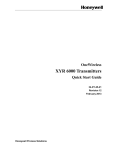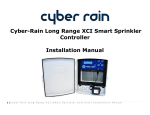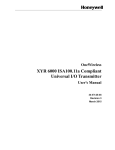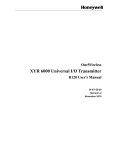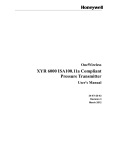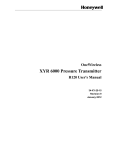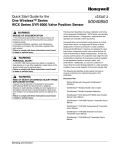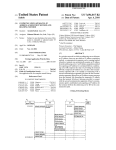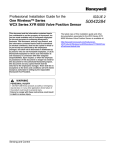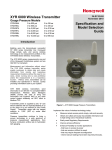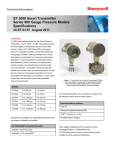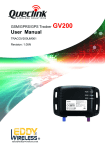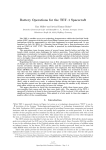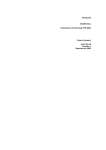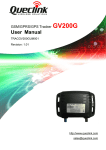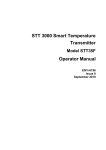Download OneWireless-XYR 6000 Transmitters
Transcript
OneWireless XYR 6000 Transmitters Quick Start Guide 34-XY-25-21 Revision 9 October 2010 Notices and Trademarks Copyright 2008 by Honeywell International Inc. Revision 9 October 2010 While this information is presented in good faith and believed to be accurate, Honeywell disclaims the implied warranties of merchantability and fitness for a particular purpose and makes no express warranties except as may be stated in its written agreement with and for its customers. In no event is Honeywell liable to anyone for any indirect, special or consequential damages. The information and specifications in this document are subject to change without notice. Honeywell, PlantScape, Experion PKS, and TotalPlant are registered trademarks of Honeywell International Inc. Other brand or product names are trademarks of their respective owners. Honeywell Process Solutions 1860 West Rose Garden Lane Phoenix, AZ 85027 ii OneWireless XYR 6000 Transmitters Quick Start Guide Revision 9 October 2010 Notices and Trademarks References About This Document This document describes mounting, installation and wiring of the XYR 6000 Wireless Transmitters and antennae. Configuration, authentication and operation are covered in other documents. Honeywell does not recommend using devices for critical control where there is a single point of failure or where single points of failure result in unsafe conditions. OneWireless is targeted at open loop control, supervisory control, and controls that do not have environmental or safety consequences. As with any process control solution, the end-user must weigh the risks and benefits to determine if the products used are the right match for the application based on security, safety, and performance. Additionally, it is up to the end-user to ensure that the control strategy sheds to a safe operating condition if any crucial segment of the control solution fails. Revision Information Document Name XYR 6000 Transmitters Quick Start Guide Document No. 34-XY-25-21 Rev. No. Publication Date ATEX and IECEx control drawings and Multi DI manual added 5 April 2009 Product Ratings tables, STUW700/701/8x0, Universal IO, 2dBi and 4dBi antenna and 24V Power Supply details added 6 Sept 2009 FM/CSA/IECEx approval updates 7 Nov 2009 ATEX approval updates 8 March 2010 ISA Battery Pack added 9 August 2010 References The following list identifies all documents that may be sources of reference for material discussed in this publication. Document Title Document number Getting Started with Honeywell OneWireless Solutions OW-CDX010 OneWireless Wireless Builder User’s Guide OW-CDX060 OneWireless Builder Parameter Reference OW-CDX070 OneWireless XYR 6000 Pressure Transmitter User's Manual 34-XY-25-15 OneWireless XYR 6000 Temperature and DI Transmitter User's Manual 34-XY-25-16 OneWireless XYR 6000 HLAI Transmitter User's Manual 34-XY-25-17 OneWireless XYR 6000 SmartCET Corrosion Transmitter User's Manual 34-XY-25-18 OneWireless XYR 6000 Multi Discrete Input Transmitter User's Manual 34-XY-25-27 OneWireless XYR 6000 Universal Input/Output User's Manual 34-XY-25-30 Revision 9 October 2010 OneWireless XYR 6000 Transmitters Quick Start Guide iii Notices and Trademarks References Support and contact info United States and Canada Contact: Honeywell Process Solution Global Technical Support - Phone: 001-800-423-9883 Customer Service (HFS) - Phone: 001-800-343-0228 Outside United States - Phone: 001-215-641-3610 Calls are answered by dispatcher between 6:00 am and 4:00 pm Mountain Standard Time. Emergency calls outside normal working hours are received by an answering service and returned within one hour. Email support: [email protected] Mail: Honeywell Process Solutions 1860 West Rose Garden Lane, Phoenix, Arizona 85027 Europe Contact: Phone: Facsimile: Mail: Honeywell TAC-EMEA +32-2-728-2732 +32-2-728-2696 TAC-BE02 Hermes Plaza Hermeslaan, 1H B-1831 Diegem, Belgium Contact: Phone: Honeywell Global TAC – Pacific 1300-300-4822 (toll free within Australia) +61-8-9362-9559 (outside Australia) +61-8-9362-9564 Honeywell Limited Australia 5 Kitchener Way Burswood 6100, Western Australia [email protected] Pacific Facsimile: Mail: Email: India Contact: Phone: Facsimile: Mail: Email: Honeywell Global TAC – India +91-20- 6603-9400 +91-20- 6603-9800 Honeywell Automation India Ltd. 56 and 57, Hadapsar Industrial Estate Hadapsar, Pune –411 013, India [email protected] Korea Contact: Phone: Facsimile: Mail: Email: iv Honeywell Global TAC – Korea +82-2-799-6317 +82-11-9227-6324 +82-2-792-9015 Honeywell Co., Ltd 17F, Kikje Center B/D, 191, Hangangro-2Ga Yongsan-gu, Seoul, 140-702, Korea [email protected] OneWireless XYR 6000 Transmitters Quick Start Guide Revision 9 October 2010 Notices and Trademarks References People’s Republic of China Contact: Honeywell Global TAC – China Phone: +86- 21-5257-4568 Mail: Honeywell (China) Co., Ltd 33/F, Tower A, City Center, 100 Zunyi Rd. Shanghai 200051, People’s Republic of China Email: [email protected] Singapore Contact: Phone: Facsimile: Mail: Email: Honeywell Global TAC – South East Asia +65-6580-3500 +65-6580-3501 +65-6445-3033 Honeywell Private Limited Honeywell Building 17, Changi Business Park Central 1 Singapore 486073 [email protected] Taiwan Contact: Phone: Facsimile: Mail: Email: Honeywell Global TAC – Taiwan +886- 7- 536-2567 +886-7-536-2039 Honeywell Taiwan Ltd. 17F-1, No. 260, Jhongshan 2nd Road. Cianjhen District Kaohsiung, Taiwan, ROC [email protected] Japan Contact: Phone: Facsimile: Mail: Email: Honeywell Global TAC – Japan +81-3-6730-7160 +81-3-6730-7228 Honeywell Japan Inc. New Pier Takeshiba, South Tower Building, 20th Floor, 1-16-1 Kaigan, Minato-ku, Tokyo 105-0022, Japan [email protected] World Wide Web Honeywell Solution Support Online: http://www.honeywell.com/ps Elsewhere Call your nearest Honeywell office. Training Classes Honeywell Automation College: http://www.automationcollege.com Revision 9 October 2010 OneWireless XYR 6000 Transmitters Quick Start Guide v Notices and Trademarks Symbol Definitions Symbol Definitions The following table lists those symbols used in this document to denote certain conditions. Symbol Definition ATTENTION: Identifies information that requires special consideration. TIP: Identifies advice or hints for the user, often in terms of performing a task. CAUTION Indicates a situation which, if not avoided, may result in equipment or work (data) on the system being damaged or lost, or may result in the inability to properly operate the process. CAUTION: Indicates a potentially hazardous situation which, if not avoided, may result in minor or moderate injury. It may also be used to alert against unsafe practices. CAUTION symbol on the equipment refers the user to the product manual for additional information. The symbol appears next to required information in the manual. WARNING: Indicates a potentially hazardous situation, which, if not avoided, could result in serious injury or death. WARNING symbol on the equipment refers the user to the product manual for additional information. The symbol appears next to required information in the manual. WARNING, Risk of electrical shock: Potential shock hazard where HAZARDOUS LIVE voltages greater than 30 Vrms, 42.4 Vpeak, or 60 VDC may be accessible. ESD HAZARD: Danger of an electro-static discharge to which equipment may be sensitive. Observe precautions for handling electrostatic sensitive devices. Protective Earth (PE) terminal: Provided for connection of the protective earth (green or green/yellow) supply system conductor. Functional earth terminal: Used for non-safety purposes such as noise immunity improvement. NOTE: This connection shall be bonded to Protective Earth at the source of supply in accordance with national local electrical code requirements. Earth Ground: Functional earth connection. NOTE: This connection shall be bonded to Protective Earth at the source of supply in accordance with national and local electrical code requirements. Chassis Ground: Identifies a connection to the chassis or frame of the equipment shall be bonded to Protective Earth at the source of supply in accordance with national and local electrical code requirements. continued vi OneWireless XYR 6000 Transmitters Quick Start Guide Revision 9 October 2010 Notices and Trademarks Symbol Definitions Symbol Definition ® The Factory Mutual Approval mark means the equipment has been rigorously tested and certified to be reliable. The Canadian Standards mark means the equipment has been tested and meets applicable standards for safety and/or performance. The Ex mark means the equipment complies with the requirements of the European standards that are harmonised with the 94/9/EC Directive (ATEX Directive, named after the French "ATmosphere EXplosible"). For radio equipment used in the European Union in accordance with the R&TTE Directive the CE Mark and the notified body (NB) identification number is used when the NB is involved in the conformity assessment procedure. The alert sign must be used when a restriction on use (output power limit by a country at certain frequencies) applies to the equipment and must follow the CE marking. The C-Tick mark is a certification trade mark registered to ACMA (Australian Communications and Media Authority) in Australia under the Trade Marks Act 1995 and to RSM in New Zealand under section 47 of the NZ Trade Marks Act. The mark is only to be used in accordance with conditions laid down by ACMA and RSM. This mark is equal to the CE Mark used in the European Union. N314 directly under the logo is Honeywell’s unique supplier identification number. Revision 9 October 2010 OneWireless XYR 6000 Transmitters Quick Start Guide vii Symbol Definitions Contents Support and contact info .......................................................................................................................iv 1. INTRODUCTION .................................................................................................... 1 1.1 Site preparation .............................................................................................................................1 1.2 European Union Usage.................................................................................................................1 1.3 Certifications and approvals........................................................................................................2 Hazardous location certifications ........................................................................................................................... 2 Radio certifications................................................................................................................................................. 3 Radio Frequency (RF) statement........................................................................................................................... 3 European Union restriction..................................................................................................................................... 3 Restriction .............................................................................................................................................................. 3 Japanes Restrictions.............................................................................................................................................. 3 2. TRANSMITTER MOUNTING ................................................................................. 6 2.1 Weight ............................................................................................................................................6 2.2 Dimensions ....................................................................................................................................6 2.3 Transmitter location....................................................................................................................12 Pressure models .................................................................................................................................................. 12 2.4 Conduit / Cable Entries...............................................................................................................12 2.5 Bracket mounting........................................................................................................................13 Attach bracket to pipe .......................................................................................................................................... 13 Attach transmitter to bracket ................................................................................................................................ 14 2.6 Rotate transmitter housing ........................................................................................................15 2.7 Rotate display..............................................................................................................................15 Tools required ...................................................................................................................................................... 15 Procedure ............................................................................................................................................................ 15 3. PROCESS INSERTION ....................................................................................... 17 3.1 Pressure models .........................................................................................................................17 Piping ................................................................................................................................................................... 17 Process connections ............................................................................................................................................ 19 General piping guidelines..................................................................................................................................... 19 3.2 Temperature and Discrete Input models ..................................................................................20 Insert probe into process...................................................................................................................................... 20 Integral probe wiring ............................................................................................................................................ 20 Remote probe wiring ............................................................................................................................................ 20 3.3 HLAI models ................................................................................................................................21 Connect wiring ..................................................................................................................................................... 21 3.4 Universal I/O ................................................................................................................................22 Connect wiring ..................................................................................................................................................... 22 Wiring for calibration – XYR6000 Universal I/O Wiring Diagrams for AI/DI (Model STUW700) ........................... 23 Wiring for calibration – XYR 6000 Universal I/O Wiring Diagrams for AI/DI/DO (Model STUW701) .................... 24 viii OneWireless XYR 6000 Transmitters Quick Start Guide Revision 9 October 2010 Contents Symbol Definitions 3.5 Corrosion models........................................................................................................................26 Probe mounting locations .....................................................................................................................................26 Probe installation ..................................................................................................................................................29 Connect wiring......................................................................................................................................................30 4. ANTENNA ADJUSTMENT AND MOUNTING ..................................................... 31 4.1 Requirements ..............................................................................................................................31 Radio installation requirements ............................................................................................................................31 4.2 Integral antenna...........................................................................................................................31 Elbow....................................................................................................................................................................32 Straight .................................................................................................................................................................32 4.3 Remote antenna ..........................................................................................................................33 Outdoor installation warnings ...............................................................................................................................33 Choosing a Mounting Location .............................................................................................................................34 Site Selection .......................................................................................................................................................34 Mounting the Antenna ..........................................................................................................................................35 Directional mounting procedure............................................................................................................................37 Omnidirectional mounting procedure....................................................................................................................38 Grounding the antenna.........................................................................................................................................38 5. START UP............................................................................................................ 40 5.1 Battery Power Option .................................................................................................................40 Connect batteries .................................................................................................................................................40 IS Battery Holder, 50025288-502 .........................................................................................................................41 IS Battery Pack, 50047517-501............................................................................................................................43 24 Vdc Power Supply Option (DC) System Diagram............................................................................................45 5.2 Display sequence ........................................................................................................................46 5.3 Provisioning.................................................................................................................................46 6. CERTIFICATION INSTALLATION REQUIREMENTS......................................... 47 6.1 Certification Drawings ................................................................................................................47 Revision 9 October 2010 OneWireless XYR 6000 Transmitters Quick Start Guide ix 1. Introduction Tables Table 2-1Display adjustment .......................................................................................................................16 Table 5-1: Battery replacement procedure ..................................................................................................42 Table 5-2: IS Battery Pack replacement procedure.....................................................................................43 Figures Figure 1 Temperature/DI/Multi DI/HLAI/Corrosion transmitter dimensions...................................................6 Figure 2 Universal I/O Temperature/DI/Multi DI/HLAI/Corrosion antenna dimensions .................................7 Figure 3 DP/DHGP Pressure transmitter dimensions ...................................................................................8 Figure 4 DP/DHGP Pressure antenna dimensions .......................................................................................9 Figure 5 GP/AP Pressure transmitter dimensions.......................................................................................10 Figure 6 GP/AP Pressure antenna dimensions...........................................................................................11 Figure 7 Common bracket orientations .......................................................................................................13 Figure 8 Rotating transmitter housing .........................................................................................................15 Figure 9 Display rotation..............................................................................................................................16 Figure 10 Typical 3-valve manifold and blow-down piping arrangement ....................................................17 Figure 11 Typical Arrangement for ½” NPT Process Connection Piping ....................................................18 Figure 12 Temperature probes ....................................................................................................................20 Figure 13 HLAI connection ..........................................................................................................................21 Figure 14 Voltage input wiring .....................................................................................................................21 Figure 15 Current input wiring .....................................................................................................................21 Figure 16 Universal I/O Connection ............................................................................................................22 Figure 17 Corrosion transmitter with remote probe.....................................................................................30 Figure 18 Elbow antenna adjustment ..........................................................................................................32 Figure 19 Integral straight antenna..............................................................................................................32 Figure 20 Directional antenna mounting......................................................................................................37 Figure 21 Omnidirection antenna mounting ................................................................................................38 Figure 22: Battery assembly ........................................................................................................................41 Figure 2: IS Battery Pack.............................................................................................................................43 Figure 24 Power Option 24V .......................................................................................................................44 Figure 25 External 24V Power Module........................................................................................................44 Figure 26 Power Supply 24 Vdc Option (DC) System Diagram ..................................................................45 x OneWireless XYR 6000 Transmitters Quick Start Guide Revision 9 October 2010 Introduction - Site preparation 1. Introduction 1.1 Site preparation Wireless devices require proper site preparation to ensure optimum performance and safety compliance. Do not proceed until you have done the proper planning described in the Wireless Planning Guide. 1.2 European Union Usage This product may be used in any of the following European Union nations. ISO 3166 ISO 3166 Country Country 2 letter code 2 letter code Austria AT Latvia LV Belgium BE Liechtenstein LI Bulgaria BG Lithuania LT Cyprus CY Malta MT Czech Republic CZ Netherlands NL Denmark DK Norway NO Estonia EE Poland PL Finland FI Portugal PT France FR Romania RO Germany DE Slovakia SK Greece GR Slovenia SI Hungary HU Spain ES Iceland IS Sweden SE Ireland IE Switzerland CH Italy IT United Kingdom BG Revision 9 October 2010 OneWireless XYR 6000 Transmitters Quick Start Guide 1 1. Introduction 1.3 Certifications and approvals Hazardous location certifications Refer to product label for applicable approvals. Approval / Item Ratings / Description CSAcus Intrinsically Safe CL I, Div 1, Groups A, B, C, & D; CL II, Div 1, Groups E, F & G; CL III, T4 CSAcus Explosion proof CL I, Div 1, Groups A, B, C, & D; CL II, Div 1, Groups E, F & G; CL III, T4 CL I, Zone 0: Ex ia IIC, T4; CL I, Zone 0: AEx ia IIC, T4 CL I, Zone 1: Ex d IIC, T4; CL I, Zone 1: AEx d IIC, T4 CSAcus Non-incendive CL I, Div 2, Groups A, B, C & D; CL II, Div 2, Groups F & G; CL III, Div 2, T4 CL I, Zone 2: Ex nA IIC, T4; CL I, Zone 2: AEx nA IIC, T4 FM Approvals CL I, Div 1, Groups A, B, C, & D; CL II, Div 1, Groups E, F & G; CL III, T4 Intrinsically Safe CL I, Zone 0: AEx ia IIC, T4 FM Approvals CL I, Div 1, Groups A, B, C, & D; CL II, Div 1, Groups E, F & G; CL III, T4 Explosion proof CL I, Zone 1: AEx d IIC, T4 FM Approvals CL I, Div 2, Groups A, B, C & D; CL II, Div 2, Groups F & G; CL III, Div 2, T4 Non-incendive CL I, Zone 2: AEx nA IIC, T4 HON – ATEX , Ex nA IIC, T4; Ta = 85°C, Zone 2 Non-Sparking KEMA 08 ATEX0062X Ex ia IIB; T4 Ta = 70ºC; Ex tD A20 IP66 T90ºC Intrinsically Safe Ex d [ia] IIB; T4 Ta = 70ºC; Ex tD A21 IP66 T90ºC Flameproof Non-Sparking Ex nA [nL] IIC; T4 Ta = 85ºC; Ex tD A22 IP66 T90ºC IECEx CSA 08.0007X Intrinsically Safe Ex ia IIB; T4 Ta = 70ºC; DIP A20 IP66 T90ºC Ex d [ia] IIB; T4 Ta = 70ºC; DIP A21 IP66 T90ºC Flameproof Ex nA [nL] IIC; T4 Ta = 85ºC; DIP A22 IP66 T90ºC Non-Sparking Process Connections in Division 2 / Zone 2 Division 2 / Zone 2 apparatus may only be connected to processes classified as non-hazardous or Division 2 / Zone 2. Connection to hazardous (flammable or ignition capable) Division 1 / Zone 0, or 1 process is not permitted. Enclosure Type Type 4X, IP 66 CRN Canadian Registration Number Class II and III installations and Type 4X/IP66 applications require that all cable and unused entries be sealed with a NRTL (National Recognized Testing Laboratory) listed cable gland or conduit plug. Cable glands and conduit plugs are not supplied with the product. 2 OneWireless XYR 6000 Transmitters Quick Start Guide Revision 9 October 2010 Introduction - Certifications and approvals Radio certifications Agency Certification Federal Communications Commission (FCC) FCC ID: S5750016517 or FCC ID: S5750025034 IC: 573I-50016517 Industry Canada (IC) or IC: 5731-50025034 Description The XYR 6000 Wireless Transmitters comply with part 15 of the FCC rules. Operation is subject to the following two conditions. (1) this device may not cause harmful interference, and (2) this device must accept any interference received, including interference that may cause undesired operation. The installer of this radio equipment must ensure that the antenna is located or pointed such that it does not emit RF fields in excess of Health Canada limits for the general population; consult Safety Code 6, obtainable from Health Canada’s web site www.hc-sc.gc.ca/rpb. Radio Frequency (RF) statement To comply with FCC’s and Industry Canada’s RF exposure requirements, the following antenna installation and device operating configurations must be satisfied. Remote Point-to-Multi-Point antenna(s) for this unit must be fixed and mounted on outdoor permanent structures with a separation distance between the antenna(s) of greater than 20cm and a separation distance of at least 20cm from all persons. Remote Fixed Point–to-Point antenna(s) for this unit must be fixed and mounted on outdoor permanent structures with a separation distance between the antenna(s) of greater than 20cm and a separation distance of at least 100cm from all persons. Furthermore, when using integral antenna(s) the XYR 6000 Wireless Transmitter unit must not be colocated with any other antenna or transmitter device and have a separation distance of at least 20cm from all persons. European Union restriction The XYR 6000 Wireless Transmitters are in conformity with the applicable portions of the ETSI standards as required by the R&TTE Directive 1999/5/EC. Restriction France restricts outdoor use to 10mW (10dBm) EIRP in the frequency range of 2,454-2,483.5 MHz. Installations in France must limit EIRP to 10dBm, for operating modes utilizing frequencies in the range of 2,454 – 2,483.5MHz. Japanes Restrictions For locations in Japan the transmitter power is restricted to 12.14dBm/Mhz {(32mW (15.4 dBm)] maximum EIRP including the antenna. ATTENTION: THIS PRODUCT IS SUPPLIED WITH PLASTIC DUST PLUGS IN THE CONDUIT/CABLE GLAND ENTRIES. IT IS THE USERS RESPONSIBILITY TO PROVIDE CABLE GLANDS, ADAPTORS AND/OR BLANKING PLUGS SUITABLE FOR THE ENVIRONMENT IN WHICH THIS PRODUCT IS INSTALLED. WHEN INSTALLED IN A HAZARDOUS LOCATION THE CABLE GLANDS, ADAPTORS AND/OR BLANKING PLUGS SHALL ADDITIONALLY BE SUITABLE FOR THE HAZARDOUS LOCATION, THE PRODUCT CERTIFICATION AND ACCEPTABLE TO THE AUTHORITY HAVING JURISDICTION FOR THE INSTALLATION. Revision 9 October 2010 OneWireless XYR 6000 Transmitters Quick Start Guide 3 Product Ratings Pressure Temperature (Integral Probe) / DI Corrosion with Remote Probe** Temperature / Discrete Input (Remote Inputs) High Level Analog Input Universal I/O (HLAI) Item Rating / Description Power Option Code Process Connections WARNING – Division 2 / Zone 2 apparatus must only be connected to a non-hazardous process BA (Battery), DC (24Vdc Supply) CSA, FM, ATEX, IECEx & SAEx YES --------- YES --------- --------- --------- Maximum Process Temperature BA (Battery), DC (24Vdc Supply) CSA, FM, ATEX, IECEx & SAEx +125ºC +85ºC Probe Rating Sensor Rating --------- --------- Maximum Allowable Pressure (MAWP) BA (Battery), DC (24Vdc Supply) CSA, FM, ATEX, IECEx & SAEx Meter Body MAWP Rating Probe / Thermowell MAWP Rating Probe --------- --------- --------- MAWP Rating Hazardous Location Protection Type BA (Battery), DC (24Vdc Supply) CSA, FM, ATEX, IECEx & SAEx XP, IS, NI, Non-Sparking IS, NI, Non-Sparking IS, NI, Non-Sparking XP, IS, NI, Non-Sparking XP, IS, NI, XP, IS, NI, Non-Sparking Non-Sparking BA (Battery) CSA & FM Div 1, Div 2, Zone 0, 1 & 2 -40 to +85ºC -40 to +85ºC -30 to +85ºC -40 to +85ºC -40 to +85ºC -40 to +85ºC DC (24Vdc Supply) CSA & FM Div 1, Div 2, Zone 0, 1 & 2 -40 to +80ºC -40 to +80ºC -30 to +80ºC -40 to +80ºC -40 to +80ºC -40 to +80ºC ATEX, IECEx & SAEx Zone 0 & 1 -40 to +70ºC -40 to +70ºC -30 to +70ºC -40 to +70ºC -40 to +70ºC -40 to +70ºC ATEX, IECEx & SAEx Zone 2 -40 to +84ºC -40 to +84ºC -30 to +84ºC -40 to +84ºC -40 to +84ºC -40 to +84ºC ATEX, IECEx & SAEx Zone 0 & 1 -40 to +70ºC -40 to +70ºC -30 to +70ºC -40 to +70ºC -40 to +70ºC -40 to +70ºC ATEX, IECEx & SAEx Zone 2 -40 to +80ºC -40 to +80ºC -30 to +80ºC -40 to +80ºC -40 to +80ºC -40 to +80ºC Process Limits Wireless Transmitters Ambient Temperature Limits BA (Battery) DC (24Vdc Supply) 4 Certification OneWireless XYR 6000 Transmitters Quick Start Guide Revision 9 October 2010 1. Introduction 1.3. Certifications and approvals Product Ratings, continued Item Rating / Description Temperature / Discrete Input (Remote Inputs) Certification Pressure CSA & FM Div 1 & Div 2 2 1 1 1 1 1 ATEX, IECEx & SAEx Zone 0 & 1 2 1 1 1 1 1 CSA & FM Div 1 & Div 2 1 1/0 0 0 0 0 ATEX, IECEx & SAEx Zone 0 & 1 1 1/0 0 0 0 0 BA (Battery) CSA & FM Explosion proof, Div 1 --------- --------- --------- YES YES YES DC (24Vdc Supply) CSA & FM Explosion proof, Div 1 YES --------- --------- YES YES YES BA (Battery) CSA & FM NonIncendive, Div 2, ATEX, IECEx & SAEx, Zone 0, 1 & 2 --------- --------- --------- YES YES YES DC (24Vdc Supply) CSA & FM NonIncendive, Div 2, ATEX, IECEx & SAEx, Zone 0, 1 & 2 YES YES YES YES YES YES BA (Battery) CSA & FM NonIncendive, Div 2, ATEX, IECEx & SAEx, Zone 0, 1 & 2 --------- --------- --------- YES YES YES DC (24Vdc Supply) CSA & FM NonIncendive, Div 2, ATEX, IECEx & SAEx, Zone 0, 1 & 2 YES YES YES YES YES YES *½ NPT High Level Analog Input Universal I/O (HLAI) BA (Battery) Quantity of Entry Plugs Required M20 (Supplied by the User) *½ NPT DC (24Vdc Supply) M20 Rigid Metal Conduit per Electrical Code Field Wiring Connections (Supplied by the User) Corrosion with Remote Probe** Temperature (Integral Probe) / DI Power Option Code Ordinary Location Conduit (EMT, PVC, Etc.) Cable and Cable Gland * ½ NPT entries may be specified for ATEX, IECEx and SAEx certifications. ** Cable gland supplied by the user is required for Corrosion Probe. Revision 9 October 2010 OneWireless XYR 6000 Transmitters Quick Start Guide 5 2. Transmitter Mounting 2.1. Weight 2. Transmitter Mounting 2.1 Weight Transmitter model 2.2 Weight STDW9xx STGW9x4 11 lbs (5 kg) STGW9xL STAW94L 7 lbs (3.2 kg) STIW400 STTW40x STTW500 STIW600 STUW700 STUW701 STTW8x0 CETW6000M 6 lbs (2.7 kg) Dimensions Figure 2-1 Temperature/DI/Multi DI/HLAI/Corrosion transmitter dimensions 6 OneWireless XYR 6000 Transmitters Quick Start Guide Revision 9 October 2010 2. Transmitter Mounting 2.2. Dimensions 240,80 9.48 Figure 2-2 Universal I/O Temperature/DI/Multi DI/HLAI/Corrosion antenna dimensions (1) Add 139,0mm/5.47 in. To these dimensions for transmitters supplied with 4 dBi Antenna option. Revision 9 October 2010 OneWireless XYR 6000 Transmitters Quick Start Guide 7 2. Transmitter Mounting 2.2. Dimensions Figure 2-3 DP/DHGP Pressure transmitter dimensions 8 OneWireless XYR 6000 Transmitters Quick Start Guide Revision 9 October 2010 2. Transmitter Mounting 2.2. Dimensions 240,80 9.48 Figure 2-4 DP/DHGP Pressure antenna dimensions (1) Add 139,0mm/5.47 in. To these dimensions for transmitters supplied with 4 dBi Antenna option. Revision 9 October 2010 OneWireless XYR 6000 Transmitters Quick Start Guide 9 2. Transmitter Mounting 2.2. Dimensions Figure 2-5 GP/AP Pressure transmitter dimensions 10 OneWireless XYR 6000 Transmitters Quick Start Guide Revision 9 October 2010 2. Transmitter Mounting 2.2. Dimensions Figure 2-6 GP/AP Pressure antenna dimensions (1) Add 139,0mm/5.47 in. To these dimensions for transmitters supplied with 4 dBi Antenna option. Revision 9 October 2010 OneWireless XYR 6000 Transmitters Quick Start Guide 11 2. Transmitter Mounting 2.3. Transmitter location 2.3 Transmitter location Pressure models Process Suggested location Gases Above the gas line The condensate drains away from the transmitter. Liquids Below but close to the This minimizes the static head elevation of the process connection. Level with or above the process connection. 2.4 effect of the condensate. This requires a siphon to protect the transmitter from process steam. The siphon retains water as a “fill fluid.” Conduit / Cable Entries NOTICE 12 Explanation THIS PRODUCT IS SUPPLIED WITH PLASTIC DUST PLUGS IN THE CONDUIT/CABLE GLAND ENTRIES. IT IS THE USERS RESPONSIBILITY TO PROVIDE CABLE GLANDS, ADAPTORS AND/OR BLANKING PLUGS SUITABLE FOR THE ENVIRONMENT IN WHICH THIS PRODUCT IS INSTALLED. WHEN INSTALLED IN A HAZARDOUS LOCATION THE CABLE GLANDS, ADAPTORS AND/OR BLANKING PLUGS SHALL ADDITIONALLY BE SUITABLE FOR THE HAZARDOUS LOCATION, THE PRODUCT CERTIFICATION AND ACCEPTABLE TO THE AUTHORITY HAVING JURISDICTION FOR THE INSTALLATION OneWireless XYR 6000 Transmitters Quick Start Guide Revision 9 October 2010 2. Transmitter Mounting 2.5. Bracket mounting 2.5 Bracket mounting Attach bracket to pipe Figure 2-7 shows some commonly used bracket and pipe orientations. Not all possibilities are shown; you can use any bracket (flat or angle) and orientation (parallel or transverse) to get the desired transmitter positioning. Position bracket on 2-inch (50.8 mm) pipe and install “U” bolt around pipe and through holes in bracket. Secure with nuts and lockwashers provided. B A C D F E Figure 2-7 Common bracket orientations Revision 9 October 2010 OneWireless XYR 6000 Transmitters Quick Start Guide 13 2. Transmitter Mounting 2.5. Bracket mounting Attach transmitter to bracket Align appropriate mounting holes in transmitter with holes in bracket and secure the transmitter to the bracket with bolts and washers provided. If the meter body is hexagonal, you must use the additional bracket supplied. If meter body is round, discard the bracket. 14 Transmitter type Attachment to bracket DP type with double-ended process heads and/or remote seals Alternate mounting holes in end of heads. Dual head GP Mounting holes in end of process head In-line GP and AP (LGP model) Smaller “U” bolt. Temperature/DI Smaller “U” bolt. Multiple DI Smaller “U” bolt. High Level Analog Input Smaller “U” bolt. Corrosion Smaller “U” bolt. Universal I/O Smaller “U” bolt. Example A B C D C OneWireless XYR 6000 Transmitters Quick Start Guide B A Revision 9 October 2010 2. Transmitter Mounting 2.6. Rotate transmitter housing 2.6 Rotate transmitter housing You can rotate the transmitter for better viewing, access, or antenna position. Loosen set screw (see A in Figure 2-8) on outside neck of transmitter one full turn. Rotate transmitter housing up to 180 degrees in either direction to desired position. CAUTION Do not rotate the housing past 180 degrees in any direction or you could damage the internal wiring. Tighten set screw. A CAUTION: Do not rotate more than 1800 Figure 2-8 Rotating transmitter housing 2.7 Rotate display If the transmitter’s mounting is such that the display is not horizontal, you can rotate the display in 90 degree increments to provide horizontal viewing. Tools required #1 Phillips Screwdriver or 1/8” Slotted Screwdriver Torque Screwdriver 1.5 mm hex key Procedure WARNING Risk of death or serious injury by explosion. Do not open transmitter enclosure when an explosive gas atmosphere is present. Revision 9 October 2010 OneWireless XYR 6000 Transmitters Quick Start Guide 15 2. Transmitter Mounting 2.7. Rotate display CAUTION Take precautions against electrostatic discharge to prevent damaging the display/sensor module. Table 2-1Display adjustment Step Action 1 Honeywell recommends that the transmitter be removed from service and moved to a clean area before servicing. 2 Loosen the M3 locking set screw on the display end-cap. See item 1 in Figure 2-9. Unscrew and remove the end cap. 3 Loosen the two captive screws on the display/sensor module. See items 2 in Figure 2-9. 4 Rotate the display 90 or 180 degrees in either direction so the screws line up with the threaded holes. Do not rotate more than 180 degrees or you could damage the wires behind the display. 5 Re-attach the display’s two captive screws. Tighten to 0,4 – 0,6 N-m (3.5 – 5.3 lb-in.). 6 Replace end cap and tighten M3 locking screw. 2 1 2 Figure 2-9 Display rotation 16 OneWireless XYR 6000 Transmitters Quick Start Guide Revision 9 October 2010 3. Process insertion 3.1. Pressure models 3. Process insertion 3.1 Pressure models Piping The actual piping arrangement will vary depending upon the process measurement requirements and the transmitter model. Except for flanged and remote diaphragm seal connections, process connections are made to ¼ inch or ½ inch NPT female connections in the process head of the transmitter’s meter body. For example, a differential pressure transmitter comes with double ended process heads with ¼ inch NPT connections but they can be modified to accept ½ inch NPT through optional flange adapters. Some gauge pressure transmitters may have a ½ inch NPT connection which mounts directly to a process pipe. The most common type of pipe used is ½ inch schedule 80 steel pipe. Many piping arrangements use a three-valve manifold to connect the process piping to the transmitter. A manifold makes it easy to install and remove or rezero a transmitter without interrupting the process. It also accommodates the installation of blow-down valves to clear debris from pressure lines to the transmitter. Figure 3-1 shows a diagram of a typical piping arrangement using a 3-valve manifold and blow-down lines for a differential pressure transmitter being used to measure flow. To Downstream Tap Blow-Down Valve To Upstream Tap Blow-Down Valve 3-Valve Manifold Blow-Down Piping Blow-Down Piping To Low Pressure Side of Transmitter To Waste To High Pressure Side of Transmitter To Waste 21010 Figure 3-1 Typical 3-valve manifold and blow-down piping arrangement Revision 9 October 2010 OneWireless XYR 6000 Transmitters Quick Start Guide 17 3. Process insertion 3.1. Pressure models Another piping arrangement uses a block-off valve and a tee connector in the process piping to the transmitter as shown in Figure 3-2. Tank wall ½” NPT Connection Block-off valve Figure 3-2 Typical Arrangement for ½” NPT Process Connection Piping ATTENTION For liquid or steam, the piping should slope a minimum of 25.4 mm (1 inch) per 305 mm (1 foot). Slope the piping down towards the transmitter if the transmitter is below the process connection so the bubbles may rise back into the piping through the liquid. If the transmitter is located above the process connection, the piping should rise vertically above the transmitter; then slope down towards the flowline with a vent valve at the high point. For gas measurement, use a condensate leg and drain at the low point (freeze protection may be required here). CAUTION Property damage may result if operating temperature limits of transmitter are exceeded. Electronics housing must not exceed 85 C [185 F], meterbody temperature limit may be rated higher. Consult transmitter nameplate for meterbody temperature limits. To reduce the temperature of the process that comes into contact with the transmitter meter body, install impulse piping. As a general rule there is a 56 degree C drop (100 degrees F) in the temperature of the process for every foot (305 mm) of ½ inch uninsulated piping. 18 OneWireless XYR 6000 Transmitters Quick Start Guide Revision 9 October 2010 3. Process insertion 3.1. Pressure models Process connections Transmitter Type Differential Pressure Process Connection Process heads with ¼ inch NPT female connection Flange adapters and manifolds with ½ inch female connection are optional Gauge Pressure Process head with ½ inch NPT female connection In-line ½ inch NPT female connection In-line ½ inch NPT male 9/16 Aminco DIN19213n Process heads with ¼ inch NPT female connection Flange adapters and manifolds with ½ inch female connections are optional Absolute Pressure Process head with ½ inch NPT female connection In-line ½-inch NPT male 9/16 Aminco DIN19213n General piping guidelines When measuring fluids containing suspended solids, install permanent valves at regular intervals to blowdown piping. Blow-down all lines on new installations with compressed air or steam and flush them with process fluids (where possible) before connecting these lines to the transmitter’s meter body. Be sure all the valves in the blow-down lines are closed tight after the initial blow-down procedure and each maintenance procedure after that. Revision 9 October 2010 OneWireless XYR 6000 Transmitters Quick Start Guide 19 3. Process insertion 3.2. Temperature and Discrete Input models 3.2 Temperature and Discrete Input models Insert probe into process ATTENTION It is your responsibility to supply a suitable sealing method or gasket and mounting hardware for the probe’s service conditions. Integral Rigid Integral Spring loaded Remote Rigid Remote Spring loaded Figure 3-3 Temperature probes Integral probe wiring The integral probe is pre-wired to the transmitter at the factory. Remote probe wiring 20 Step Action 1 See Figure 3-3. Open the transmitter’s rear end cap (opposite end from display) by loosening the M3 locking screw and unscrewing the end cap. 2 Open the cable gland (on right side below antenna). (Cable gland must be ordered as an option.) 3 Feed wiring (6 to 8 mm allowed diameter) through the cable gland and connect to terminal block. For terminal connections see info starting on page 47. 4 Plug battery connector into batteries. See page 40. 5 Close rear end cap and cable gland. 6 Tighten M3 locking screw on the rear end cap. OneWireless XYR 6000 Transmitters Quick Start Guide Revision 9 October 2010 3. Process insertion 3.3. HLAI models 3.3 HLAI models Connect wiring Step Action 1 See Figure 3-4. Open the rear end cap (opposite end from display) by loosening the M3 locking screw and unscrewing the end cap. 2 Open the cable gland (on right side below antenna). (Cable gland must be ordered as an option.) 3 Feed wiring (allowed diameter 6 to 8 mm) from other transmitter through the cable gland and connect to terminal block using either voltage or current but not both. See Figure 3-5 or Figure 3-6. For hazardous locations see info starting on page 47. 4 Plug battery connector into batteries. 5 Close rear end cap and cable gland. 6 Tighten M3 locking screw on the rear end cap. To voltage/current source. See Figure 3-5 and Figure 3-6. Figure 3-4 HLAI connection 1 4 + + 2 5 - 3 6 - 0-5V 1-5V Figure 3-5 Voltage input wiring + 0-20 mA 4-20mA - + - 1 4 2 5 3 6 Figure 3-6 Current input wiring Revision 9 October 2010 OneWireless XYR 6000 Transmitters Quick Start Guide 21 3. Process insertion 3.4. Universal I/O 3.4 Universal I/O STUW700 – Three inputs (1-3) HLAI, (1-2) T/C, (1-2) Discrete Inputs STUW 701 – Two inputs (1-2) HLAI, T/C, DI + One (1) Discrete Output Connect wiring Step Action 1 See Figure 3-7. Open the rear end cap (opposite end from display) by loosening the M3 locking screw and unscrewing the end cap. 2 Open the cable gland (on right side below antenna). (Cable gland must be ordered as an option.) 3 Feed wiring (allowed diameter 6 to 8 mm) from other transmitter through the cable gland and connect to terminal block using either voltage or current but not both. See wiring diagrams pages 23 and 24. 4 Plug battery connector into batteries. 5 Close rear end cap and cable gland. 6 Tighten M3 locking screw on the rear end cap. To voltage/current source. See wiring diagrams for all models on pages 24 and 25. Figure 3-7 Universal I/O Connection 22 OneWireless XYR 6000 Transmitters Quick Start Guide Revision 9 October 2010 3. Process insertion 3.4. Universal I/O Wiring for calibration – XYR6000 Universal I/O Wiring Diagrams for AI/DI (Model STUW700) PV1 Possible Connections T/C, DI or HLAI PV2 Possible Connections T/C, DI or HLAI PV3 Possible Connections (HLAI only) Note: any combination of the above are allowed. For example: PV1 is a DI, PV2 is 4-20mA, PV3 is 0-20mA. Or PV1 is 0-20mA, PV2 is a T/C, PV3 is 0-20mA Revision 9 October 2010 OneWireless XYR 6000 Transmitters Quick Start Guide 23 3. Process insertion 3.4. Universal I/O Wiring for calibration – XYR 6000 Universal I/O Wiring Diagrams for AI/DI/DO (Model STUW701) PV1 Possible Connections T/C, DI or HLAI PV2 Possible Connections T/C, DI or HLAI PV3 Possible Connections (DO only) Note: any combination of the above are allowed. For example: PV1 is a DI, PV2 is 4-20mA, PV3 is DO. Or PV1 is 4-20mA, PV2 is a T/C, PV3 is DO 24 OneWireless XYR 6000 Transmitters Quick Start Guide Revision 9 October 2010 3. Process insertion 3.4. Universal I/O STTW 500 MULTI-DI CONNECTION TB1 S1 TB2 1 4 2 5 3 6 S3 S2 2 JUMPER WIRES NOTES: 1. Shielded switch input cable is required for EMC conformity and is recommended for all remote switch installations. The shield shall be grounded at the transmitter end only. If the shield is grounded at the switch location, the shield shall not be connected at the transmitter end. 2. Jumper wires the same gauge and stranding as the switch wires are required for all switch input combinations. 3. Switches shall be isolated from each other and from earth ground to avoid common mode noise problems. Revision 9 October 2010 OneWireless XYR 6000 Transmitters Quick Start Guide 25 3. Process insertion 3.5. Corrosion models 3.5 Corrosion models Probe mounting locations The corrosion probe must be installed in a location that is most susceptible to corrosion. In most cases, corrosion tends to occur where water is trapped or stagnant. However, it can also accelerate at the bend of the pipe or where corrosion has occurred previously, but is accelerated by high flow or turbulence. Location Picture Incorrect probe location The probe should not be mounted in a pipe drop since the corrosive liquid may not be in full contact with the electrodes. Correct probe location The probe should be mounted in the riser of a pipe near an elbow where the velocity is the highest. In general, probe should be mounted in pipes or tanks at locations of highest liquid velocity and constant immersion. Correct Pipeline Position Probe can be located at any point on the pipeline but should always be immersed in the corrosive material. 26 OneWireless XYR 6000 Transmitters Quick Start Guide Revision 9 October 2010 3. Process insertion 3.5. Corrosion models Location Picture Located in Tee Probe can be located at any point on the pipeline but should always be immersed in the corrosive material. Located in Bypass Loop Probe should be located downstream of a control valve for best performance and can also be located in the deadleg portion of a by-pass. Note that the probe located in the bypass leg should be mounted before the valve for best performance. This guarantees the electrodes will always be immersed in the corrosive material. Mounted with Different Electrodes Installing with different electrode materials on the suction side of the pump will ensure monitoring of the pump impeller and the pipe. Installed in a Condensate Flash Tank A condensate flash tank is also a good application. Revision 9 October 2010 OneWireless XYR 6000 Transmitters Quick Start Guide 27 3. Process insertion 3.5. Corrosion models Location Picture Mounted in Y-Strainer The probe is shown in the blow down of a Y-strainer. Mounted in Basket Strainer The probe is shown in the discharge side of the basket strainer. The electrodes should be selected to reflect the same metal properties as the piping or other components that might be susceptible to corrosion. For example, in applications where the pipe is made of stainless steel and the water pump’s impeller is made of carbon steel, the impeller will corrode faster than the pipe. In this case it is advisable to select the electrodes to be the same material as the pump’s impeller. 28 OneWireless XYR 6000 Transmitters Quick Start Guide Revision 9 October 2010 3. Process insertion 3.5. Corrosion models Probe installation WARNING If the pipe or vessel into which the probe is to be inserted is under pressure and/or contains any hazardous substance, such as steam, caustic solutions, acids, toxins or other substances specified by OSHA as physical or health hazards, the pipe or vessel must first be depressurized and any hazardous substance purged there from, and appropriate lockout/tagout procedures observed in accordance with Section 1910.147 of the OSHA Regulations, before the probe can be installed. Failure to follow these procedures may result in serious injury or death. Step Action 1 11/16” Hex Flat 11/8” Hex Flat Pipe Some probes are supplied with an adjustable, compression NPT fitting (e.g. Swagelok). With this fitting, follow this tightening sequence to ensure a tight seal. a) The Swagelok fitting should be held onto place with a plastic zip-tie around the probe body. The zip-tie should be removed. b) Determine the depth that the probe should extend into the pipe. c) Tighten the larger upper nut until the tubing will not rotate freely by hand. d) Make a mark on the nut. This mark will serve as a reference as the 6 o’clock position. e) While holding fitting body steady, tighten the large upper nut 1 + 1⁄4 turns to the 9 o’clock position. f) This tightening sequence will crimp the internal ring onto the probe body and should lock the fitting in place now. g) Tighten the lower nut onto the pipe nipple or access point. For fixed type probes (without the adjustable compression fitting) only the 1 1/16 hex nut needs to be tightened and the safety bracket is not required. 2 Revision 9 October 2010 Ensure the flow rate of the process fluid does not exceed 20 feet per second (fps). Stronger flow might damage probes with three finger electrodes and interfere with the reading. If the flow rate exceeds the recommendation, a different probe style may be required. OneWireless XYR 6000 Transmitters Quick Start Guide 29 3. Process insertion 3.5. Corrosion models Connect wiring Step Action 1 See Figure 3-8. Open the transmitter’s rear end cap (opposite end from display). 2 Open the cable gland (on right side below antenna). (Cable gland must be ordered as an option.) 3 Feed probe wiring through the cable gland and connect to terminal block. See Figure 3-8. For terminal connections see info starting on page 47. 4 Plug battery connector into batteries. 5 Close rear end cap and cable gland. Figure 3-8 Corrosion transmitter with remote probe 30 OneWireless XYR 6000 Transmitters Quick Start Guide Revision 9 October 2010 4. Antenna adjustment and mounting 4.1. Requirements 4. Antenna adjustment and mounting 4.1 Requirements Radio installation requirements ATTENTION Professional Installation is required to insure conformity with Federal Communications Commission (FCC) in the USA, Industry Canada (IC) in Canada and the Radio and Telecommunications Terminal Equipment Directive, 1999/5/EC (R&TTE), in the European Union (EU). Professional installation is required for the selection and installation of approved antennas and setup of the maximum allowable radiated power from the XYR 6000 Wireless Transmitter as configured for the particular installation site. The antenna used for this transmitter must be installed to provide a separation distance of at least 20 cm (8 inches) from all persons and must not be co-located or operating in conjunction with any other antenna or transmitter. For remote antenna, see antenna installation requirements to satisfy FCC RF exposure requirements. ATTENTION Federal Communications Commission (FCC): The XYR 6000 Wireless Transmitters comply with part 15 of the FCC rules. Operation is subject to the following two conditions: (1) this device may not cause harmful interference, and (2) this device must accept any interference received, including interference that may cause undesired operation. Industry Canada (IC): The installer of this radio equipment must ensure that the antenna is located or pointed such that it does not emit RF fields in excess of Health Canada limits for the general population; consult Safety Code 6, obtainable from Health Canada’s web site www.hc-sc.gc.ca/rpb. 4.2 Integral antenna WARNING POTENTIAL ELECTROSTATIC CHARGING HAZARD The integrally mounted antenna shroud is made of Teflon® and has a surface resistance greater than 1Gohm per square. When the XYR 6000 transmitter is installed in potentially hazardous locations care should be taken not to electrostatically charge the surface of the antenna shroud by rubbing the surface with a cloth, or cleaning the surface with a solvent. If electrostatically charged, discharge of the antenna shroud to a person or a tool could possibly ignite a surrounding hazardous atmosphere. Revision 9 October 2010 OneWireless XYR 6000 Transmitters Quick Start Guide 31 4. Antenna adjustment and mounting 4.2. Integral antenna Elbow Figure 4-1 Elbow antenna adjustment (2 dBi Antenna Configuration Shown) If your model has the integral elbow antenna you can adjust it to improve reception. Typically, pointed straight up gives best performance but your installation may vary. Loosen the 1.5mm set screw located near the antenna base. Rotate antenna for best reception. Do not rotate antenna more than 180 degrees either direction or you could damage internal wiring. Tighten set screw. Straight Figure 4-2 Integral straight antenna (Straight Antenna ONLY available in 2 dBi configuration) If your model has the integral straight antenna (Figure 4-2) you can adjust its position by rotating the transmitter housing. (See page 15.) Typically, pointed straight up gives best performance but your installation may vary. 32 OneWireless XYR 6000 Transmitters Quick Start Guide Revision 9 October 2010 4. Antenna adjustment and mounting 4.3. Remote antenna 4.3 Remote antenna Outdoor installation warnings WARNING LIVES MAY BE AT RISK! Carefully observe these instructions and any special instructions that are included with the equipment you are installing. WARNING Contacting power lines can be lethal. Look over the site before beginning any installation, and anticipate possible hazards, especially these: Make sure no power lines are anywhere where possible contact can be made. Antennas, masts, towers, guy wires or cables may lean or fall and contact these lines. People may be injured or killed if they are touching or holding any part of equipment when it contacts electric lines. Make sure there is NO possibility that equipment or personnel can come in contact directly or indirectly with power lines. Assume all overhead lines are power lines. The horizontal distance from a tower, mast or antenna to the nearest power line should be at least twice the total length of the mast/antenna combination. This will ensure that the mast will not contact power if it falls either during installation or later. WARNING To avoid falling, use safe procedures when working at heights above ground. Select equipment locations that will allow safe, simple equipment installation. Don’t work alone. A friend or co-worker can save your life if an accident happens. Use approved non-conducting ladders and other safety equipment. Make sure all equipment is in good repair. If a tower or mast begins falling, don’t attempt to catch it. Stand back and let it fall. If anything such as a wire or mast does come in contact with a power line, DON’T TOUCH IT OR ATTEMPT TO MOVE IT. Instead, save your life by calling the power company. Don’t attempt to erect antennas or towers on windy days. Revision 9 October 2010 OneWireless XYR 6000 Transmitters Quick Start Guide 33 4. Antenna adjustment and mounting 4.3. Remote antenna WARNING MAKE SURE ALL TOWERS AND MASTS ARE SECURELY GROUNDED, AND ELECTRICAL CABLES CONNECTED TO ANTENNAS HAVE LIGHTNING ARRESTORS. This will help prevent fire damage or human injury in case of lightning, static build-up, or short circuit within equipment connected to the antenna. The base of the antenna mast or tower must be connected directly to the building protective ground or to one or more approved grounding rods, using 1 OAWG ground wire and corrosion-resistant connectors. Refer to the National Electrical Code for grounding details. Lightning arrestors for antenna feed coaxial cables are available from HyperLink Technologies, Inc. WARNING If a person comes in contact with electrical power, and cannot move: DON’T TOUCH THAT PERSON, OR YOU MAY BE ELECTROCUTED. Use a non-conductive dry board, stick or rope to push or drag them so they no longer are in contact with electrical power. Once they are no longer contacting electrical power, administer CPR if you are certified, and make sure that emergency medical aid has been requested. Choosing a Mounting Location The location of the antenna is important. Objects such as metal columns, walls, etc. will reduce efficiency. Best performance is achieved when antennas for both Multinodes and XYR 6000 Transmitters (Leaf Nodes) are mounted at the same height and in a direct line of sight with no obstructions. If this is not possible and reception is poor, you should try different mounting positions to optimize reception. Antennas should be mounted clear of any obstructions to the sides of the radiating element. If the mounting location for an omnidirectional antenna is on the side of a building or tower, then the antenna pattern will be degraded on the building or tower side. Site Selection Before attempting to install your antenna, think where you can best place the antenna for safety and performance. Follow these steps to determine a safe distance from wires, power lines, and trees. Step Action 1 Measure the height of your antenna. 2 Add this length to the length of your tower or mast and then double this total for the minimum recommended safe distance. CAUTION If you are unable to maintain this safe distance, stop and get professional help. 34 OneWireless XYR 6000 Transmitters Quick Start Guide Revision 9 October 2010 4. Antenna adjustment and mounting 4.3. Remote antenna Generally speaking, the higher your antenna is above the ground, the better it performs. Good practice is to install your antenna about 5 to 10 feet (1.5 to 3 meters) above the roof line and away from all power lines and obstructions. If possible, find a mounting place directly above your wireless device so that the lead-in cable can be as direct as possible. Mounting the Antenna Antennas are provided with a mast mounting kit consisting of a mounting bracket and two U-bolt clamps. This kit allows you to mount the antenna to masts with outside diameters (O.D.) from 1.25 inches (3.2 centimeters) to 2 inches (5.1 centimeters). Honeywell recommends that a 1.5 inch (3.8 centimeter) or larger tubing mast be used. Omnidirectional antennas are vertically polarized. It is very important to mount the antenna in a vertical (not leaning) position for optimal performance. Follow these steps to mount the antenna on a mast. Step Action 1 Assemble your new antenna on the ground at the installation site. See the instructions on the following pages for your type of antenna. 2 Attach the antenna to the mast and connect its coaxial cable while you are on the ground, using the mounting kit provided with the antenna. Tighten cables by hand only; do not use tools or you could overtighten. After the cable is attached to the antenna, make sure that the connections are sealed (if outdoors) the prevent moisture and other weathering elements from effecting performance. Honeywell recommends using a weathering tape (such as Coax-Seal ) for outdoor connections. Silicon sealant or electrical tape is not recommended for sealing out door connections. 3 Using tie-wraps (cable ties), secure the coax cable to the mast, using a tie-wrap every ten to twelve inches (25 to 30 cm). 4 Follow standard strain relief practice when installing the antenna cable. Avoid excessive strain, bending, kinks, or crushing (stepping on or placing any weight on cable) before, during or after the coax cable is secured in its final position. 5 Make sure the mast does not fall the "wrong way" should you lose control as you raise or take down the mast. Use a durable non-conductive rope. Have an assistant tend to the rope; ready to pull the mast clear of any hazards (such as power lines) should it begin to fall. 6 If the installation will use guy wires: Install guy anchor bolts. Estimate the length of guy wire and cut it before raising the mast. Attach guy wires to a mast using guy rings. 7 Carefully connect the antenna and mast assembly to its mounting bracket and tighten the clamp bolts. In the case of a guyed installation, you must have at least one assistant to hold the mast upright while the guy wires are attached and tightened to the anchor bolts. 8 Attach the provided self-adhering "DANGER" label at eye level on the mast. 9 Install ground rods to remove any static electricity buildup and connect a ground wire to the mast and ground rod. Use ground rods designed for that purpose; do not use a spare piece of pipe. Revision 9 October 2010 OneWireless XYR 6000 Transmitters Quick Start Guide 35 4. Antenna adjustment and mounting 4.3. Remote antenna Step Action 10 When attaching the coax cable to the XYR 6000, it is recommended that a drip loop with a radius of at least 12 inches (30 cm) be formed close to the XYR 6000. This will minimize ice and water buildup on the transmitter itself. Tighten cables by hand only; do not use tools or you could overtighten. To lightning arrestor & antenna 12”/30cm Drip loop 36 OneWireless XYR 6000 Transmitters Quick Start Guide Revision 9 October 2010 4. Antenna adjustment and mounting 4.3. Remote antenna Directional mounting procedure Step Action 1 Secure mast mounting bracket to mast as shown using 2 U-bolts and supplied hardware. 2 Attach antenna to mast mounting bracket as shown using supplied hardware. 3 Adjust antenna to desired tilt and lock into place using the antenna tilt adjustment nut. Figure 4-3 Directional antenna mounting Revision 9 October 2010 OneWireless XYR 6000 Transmitters Quick Start Guide 37 4. Antenna adjustment and mounting 4.3. Remote antenna Omnidirectional mounting procedure Step Action 1 Secure mast mounting bracket to mast as shown using 2 U-bolts and supplied hardware. 2 Remove antenna mounting bolt and washer from antenna base. 3 Insert antenna into mounting bracket and secure with washer and antenna mounting bolt. Do not overtighten. 4 Any drain holes in the antenna base must be kept clear for proper operation. Figure 4-4 Omnidirection antenna mounting Grounding the antenna Follow these guidelines to ground the antenna in accordance with national electrical code instructions. Step 38 Action 1 Use No. 10 AWG copper or No. 8 or larger copper-clad steel or bronze wire as ground wires for both mast and lead-in. Securely clamp the wire to the bottom of the mast. 2 Secure the lead-in wire to a lightning arrestor and mast ground wire to the building with standoff insulators spaced from 4 feet (1.2 meters) to 8 feet (1.8 meters) apart. OneWireless XYR 6000 Transmitters Quick Start Guide Revision 9 October 2010 4. Antenna adjustment and mounting 4.3. Remote antenna Step Action 3 Using coaxial cable, connect the antenna base to the transmitter’s remote antenna connector (located at top right as you face the transmitter display). Antenna cable shield is bonded to earth ground via either the transmitter earth ground connection and/or by the lightning arrestor earth ground connection. The lightning arrestor must be bonded to earth ground in order to function properly. Tighten cables by hand only; do not use tools or you could overtighten. See pages 57, 68, 79 and 90 for cable types and connection information. 4 If the coax cable is to enter a building, then the lightning arrestor should be mounted as close as possible to where the lead-in wire enters the building. The lightning arrestor sold by Honeywell features a bulkhead N-Female connector with a rubber “O”-ring seal which can be used for mounting through an enclosure wall. The lightning arrestor can also be mounted using the included stainless steel mounting bracket. Both connector ports of the lightning arrestor provide equal protection no matter which way it is installed. Either port can face the antenna and either port can face the Transmitter. 5 Drill a hole in the building's wall as close as possible to the equipment to which you will connect the lead-in cable. CAUTION There may be wires in the wall. Before drilling check that the area is clear of any obstructions or other hazards. 6 Pull the cable through the hole and form a drip loop on the outside close to where the cable enters the building. The drip loop should have a radius of at least 12 inches (30 cm). To lightning arrestor & antenna 12”/30cm Drip loop 7 Thoroughly waterproof the lead-in area. 8 Connect the lead-in cable to the XYR 6000 Transmitter. Tighten cables by hand only; do not use tools or you could overtighten. Revision 9 October 2010 OneWireless XYR 6000 Transmitters Quick Start Guide 39 5. Start up 5.1. Battery Power Option 5. Start up 5.1 Battery Power Option Connect batteries WARNING Risk of death or serious injury from explosion or fire. If IS Battery Pack, Honeywell 50047517-501, has been installed in the Wireless Transmitter, the transmitter enclosure maybe opened when an explosive gas atmosphere is present. Otherwise, do not open transmitter enclosure when and explosive gas atmosphere is present. - When not in use the Battery Pack must be stored in a non Hazardous Area Do not change batteries in an explosive gas atmosphere. The batteries used in this device may present a risk of fire or chemical burn if mistreated. Do not recharge, disassemble, heat above 100°C (212°F), or incinerate. When installing batteries, do not snag the battery terminal on the clip or the battery may be damaged. Do not apply excessive force. Do not drop. Dropping the battery may cause damage. If a battery is dropped, do not install the dropped battery into the transmitter. Dispose of dropped battery promptly per local regulations or per the battery manufacturer’s recommendations. ATTENTION Both batteries must be the same model from the same manufacturer. Mixing old and new batteries or different manufacturers is not permitted. Use only the following 3.6V lithium thionyl chloride (Li-SOCl2) batteries (nonrechargeable), size D. No other batteries are approved for use in XYR 6000 Wireless Transmitters. Xeno Energy XL-205F Eagle Picher PT-2300H Tadiran TL-5930/s Honeywell p/n 50026010-501 (Two 3.6V lithium thionyl chloride batteries) Honeywell p/n 50026010-502 (Four 3.6V lithium thionyl chloride batteries) Honeywell p/n 50026010-503 (Ten 3.6V lithium thionyl chloride batteries) These instructions are divided into two procedures for: 40 IS Battery Holder, 50025288-502 IS Battery Pack, 50047517-501 OneWireless XYR 6000 Transmitters Quick Start Guide Revision 9 October 2010 5. Start up 5.1. Battery Power Option Tools required Procedure #1 Phillips Screwdriver or 1/8” Slotted Screwdriver Torque Screwdriver 1.5 mm hex key It is the User/Installer’s responsibility to install the XYR 6000 Wireless Transmitters in accordance with national and local code requirements. IS Battery Holder, 50025288-502 + + - 3 1 4 2 Figure 5-1: Battery assembly Revision 9 October 2010 OneWireless XYR 6000 Transmitters Quick Start Guide 41 5. Start up 5.1. Battery Power Option Table 5-1: Battery replacement procedure Step Action ATTENTION You must replace both batteries. Both batteries must be the same model from the same manufacturer. Mixing old and new batteries or different manufacturers is not permitted. Use only the following 3.6V lithium thionyl chloride (Li-SOCl2) batteries (non-rechargeable), size D. No other batteries are approved for use in XYR 6000 Wireless Transmitters. Xeno Energy XL-205F Eagle Picher PT-2300H Tadiran TL-5930/s Honeywell p/n 50026010-001 (Two 3.6V lithium thionyl chloride batteries) (1 transmitter) Honeywell p/n 50026010-002 (Four 3.6V lithium thionyl chloride batteries) (2 transmitters) Honeywell p/n 50026010-003 (Ten 3.6V lithium thionyl chloride batteries) (5 transmitters) 1 Loosen the M3 locking set screw on the battery end-cap (opposite end from display). See item 1 in Figure 5-1. Unscrew and remove the end cap. 2 Using thumb and forefinger, squeeze the battery connector at top and bottom to disengage the locking mechanism, then pull to disconnect. See item 2 in Figure 5-1. 3 Loosen the two battery holder retaining screws (closest to the batteries). See item 3 in Figure 5-1. The screws are captive. 4 Pull the battery holder out of the transmitter. 5 Remove the old batteries from the battery holder. If needed, pry out the batteries by using a slotted screwdriver as a lever in the holder’s side slots. See item 4 in Figure 5-1. 6 Install batteries as follows to avoid snagging the battery terminal on the clip and damaging the battery. Align the new battery with the clips and angle the positive end of the battery into the positive battery terminal clip. Using a thumb and forefinger pull the negative terminal clip outward and push down on the battery until fully seated in the clips. Do not apply excessive force when pushing battery down. Repeat this process for the second battery. 7 Insert the battery holder into the transmitter. Reattach the screws and tighten to 0.4 – 0.6 N-M (3.5 – 5.3 Lb-in). Re-connect battery connector. Honeywell recommends lubricating the end cap O-ring with a Silicone Grease such as Dow Corning #55 or equivalent before replacing the end cap. 42 8 Screw the end cap back on and tighten the M3 locking screw. 9 Dispose of used battery promptly per local regulations or the battery manufacturer’s recommendations. Keep away from children. Do not disassemble and do not dispose of in fire. OneWireless XYR 6000 Transmitters Quick Start Guide Revision 9 October 2010 5. Start up 5.1. Battery Power Option IS Battery Pack, 50047517-501 Table 5-2: IS Battery Pack replacement procedure Step Action 1 Follow steps 1-4, as above 2 WARNING DO NOT ASSEMBLE WHEN AN EXPLOSIVE ATMOSPHERE IS PRESENT Figure 5-2: IS Battery Pack 3 Remove top of battery pack by using a #1 Philips or 1/8” slotted screwdriver for the screws identified as #1 in Figure 5-2. 4 Remove the old batteries and dispose of them promptly according to local regulations of the battery manufacturer’s recommendations. 5 Install the batteries following the polarity as noted on the lid 6 Re-install top of the battery pack and tighten screws 7 Insert the Battery pack into the transmitter. Reattach the screws as indicated in Figure 5-1, item 3, to 0.4 to 0.6 N-M (3.5 – 5.3 Lb-in). Reconnect the Batter Pack connector Honeywell recommends lubricating the end cap with a silicone grease such as Dow Corning #55 or equivalent before replacing the end cap 8 Revision 9 October 2010 Screw the cap back on and tighten the M3 locking screw OneWireless XYR 6000 Transmitters Quick Start Guide 43 5. Start up 5.1. Battery Power Option 24V Wiring Connector M3 Locking Screw Power Connector Power Module Mounting Screws Figure 5-3 Power Option 24V J2 Connector Figure 5-4 External 24V Power Module 44 OneWireless XYR 6000 Transmitters Quick Start Guide Revision 9 October 2010 5. Start up 5.1. Battery Power Option 24 Vdc Power Supply Option (DC) System Diagram (Ordinary Non-Hazardous Locations) Figure 5-5 Power Supply 24 Vdc Option (DC) System Diagram Revision 9 October 2010 OneWireless XYR 6000 Transmitters Quick Start Guide 45 5. Start up 5.2. Display sequence 5.2 Display sequence After power up, the transmitter does a brief self-test of the LCD display. Then it proceeds to Power-On Message, which is the model name of the transmitter. The name is displayed for 2 seconds after which the transmitter displays the process variables and associated status. 5.3 Provisioning Before the transmitter can be configured it must be unlocked with a security key so it can join the network. Use the Provisioning Device Pocket PC software to receive security keys from the Key Server manager, then aim the Pocket PC at the transmitter and transmit a key. See Getting Started with Honeywell OneWireless Solutions for more information. 46 OneWireless XYR 6000 Transmitters Quick Start Guide Revision 9 October 2010 6. Certification Installation Requirements 6.1. Certification Drawings 6. Certification Installation Requirements 6.1 Certification Drawings Use the following drawings and accompanying notes and text for hazardous locations. Any deviation from the installation requirements could void the certification. For non-hazardous locations you can use the same drawings without the accompanying notes and text. 47 OneWireless XYR 6000 Transmitters Quick Start Guide 6. Certification Installation Requirements 48 OneWireless XYR 6000 Transmitters Quick Start Guide Revision 9 October 2010 Certification Installation Requirements - Certification Drawings Revision 9 October 2010 OneWireless XYR 6000 Transmitters Quick Start Guide 49 6. Certification Installation Requirements 50 OneWireless XYR 6000 Transmitters Quick Start Guide Revision 9 October 2010 Certification Installation Requirements - Certification Drawings Revision 9 October 2010 OneWireless XYR 6000 Transmitters Quick Start Guide 51 6. Certification Installation Requirements 52 OneWireless XYR 6000 Transmitters Quick Start Guide Revision 9 October 2010 Certification Installation Requirements - Certification Drawings Revision 9 October 2010 OneWireless XYR 6000 Transmitters Quick Start Guide 53 6. Certification Installation Requirements 54 OneWireless XYR 6000 Transmitters Quick Start Guide Revision 9 October 2010 Certification Installation Requirements - Certification Drawings Revision 9 October 2010 OneWireless XYR 6000 Transmitters Quick Start Guide 55 6. Certification Installation Requirements 56 OneWireless XYR 6000 Transmitters Quick Start Guide Revision 9 October 2010 Certification Installation Requirements - Certification Drawings Revision 9 October 2010 OneWireless XYR 6000 Transmitters Quick Start Guide 57 6. Certification Installation Requirements 58 OneWireless XYR 6000 Transmitters Quick Start Guide Revision 9 October 2010 Certification Installation Requirements - Certification Drawings Revision 9 October 2010 OneWireless XYR 6000 Transmitters Quick Start Guide 59 6. Certification Installation Requirements 60 OneWireless XYR 6000 Transmitters Quick Start Guide Revision 9 October 2010 Certification Installation Requirements - Certification Drawings Revision 9 October 2010 OneWireless XYR 6000 Transmitters Quick Start Guide 61 6. Certification Installation Requirements 62 OneWireless XYR 6000 Transmitters Quick Start Guide Revision 9 October 2010 Certification Installation Requirements - Certification Drawings Revision 9 October 2010 OneWireless XYR 6000 Transmitters Quick Start Guide 63 6. Certification Installation Requirements 64 OneWireless XYR 6000 Transmitters Quick Start Guide Revision 9 October 2010 Certification Installation Requirements - Certification Drawings Revision 9 October 2010 OneWireless XYR 6000 Transmitters Quick Start Guide 65 6. Certification Installation Requirements 66 OneWireless XYR 6000 Transmitters Quick Start Guide Revision 9 October 2010 Certification Installation Requirements - Certification Drawings Revision 9 October 2010 OneWireless XYR 6000 Transmitters Quick Start Guide 67 6. Certification Installation Requirements 68 OneWireless XYR 6000 Transmitters Quick Start Guide Revision 9 October 2010 Certification Installation Requirements - Certification Drawings Revision 9 October 2010 OneWireless XYR 6000 Transmitters Quick Start Guide 69 6. Certification Installation Requirements 70 OneWireless XYR 6000 Transmitters Quick Start Guide Revision 9 October 2010 Certification Installation Requirements - Certification Drawings Revision 9 October 2010 OneWireless XYR 6000 Transmitters Quick Start Guide 71 6. Certification Installation Requirements 72 OneWireless XYR 6000 Transmitters Quick Start Guide Revision 9 October 2010 Certification Installation Requirements - Certification Drawings Revision 9 October 2010 OneWireless XYR 6000 Transmitters Quick Start Guide 73 6. Certification Installation Requirements 74 OneWireless XYR 6000 Transmitters Quick Start Guide Revision 9 October 2010 Certification Installation Requirements - Certification Drawings Revision 9 October 2010 OneWireless XYR 6000 Transmitters Quick Start Guide 75 6. Certification Installation Requirements 76 OneWireless XYR 6000 Transmitters Quick Start Guide Revision 9 October 2010 Certification Installation Requirements - Certification Drawings Revision 9 October 2010 OneWireless XYR 6000 Transmitters Quick Start Guide 77 6. Certification Installation Requirements 78 OneWireless XYR 6000 Transmitters Quick Start Guide Revision 9 October 2010 Certification Installation Requirements - Certification Drawings Revision 9 October 2010 OneWireless XYR 6000 Transmitters Quick Start Guide 79 6. Certification Installation Requirements 80 OneWireless XYR 6000 Transmitters Quick Start Guide Revision 9 October 2010 Certification Installation Requirements - Certification Drawings Revision 9 October 2010 OneWireless XYR 6000 Transmitters Quick Start Guide 81 6. Certification Installation Requirements 82 OneWireless XYR 6000 Transmitters Quick Start Guide Revision 9 October 2010 Certification Installation Requirements - Certification Drawings Revision 9 October 2010 OneWireless XYR 6000 Transmitters Quick Start Guide 83 6. Certification Installation Requirements 84 OneWireless XYR 6000 Transmitters Quick Start Guide Revision 9 October 2010 Certification Installation Requirements - Certification Drawings Revision 9 October 2010 OneWireless XYR 6000 Transmitters Quick Start Guide 85 6. Certification Installation Requirements 86 OneWireless XYR 6000 Transmitters Quick Start Guide Revision 9 October 2010 Certification Installation Requirements - Certification Drawings Revision 9 October 2010 OneWireless XYR 6000 Transmitters Quick Start Guide 87 6. Certification Installation Requirements 88 OneWireless XYR 6000 Transmitters Quick Start Guide Revision 9 October 2010 Certification Installation Requirements - Certification Drawings Revision 9 October 2010 OneWireless XYR 6000 Transmitters Quick Start Guide 89 6. Certification Installation Requirements 90 OneWireless XYR 6000 Transmitters Quick Start Guide Revision 9 October 2010 Sales and Service For application assistance, current specifications, pricing, or name of the nearest Authorized Distributor, contact one of the offices below. ASIA PACIFIC Control Products Asia Pacific Headquarters Phone: +(65) 6355-2828 Fax: +(65) 6445-3033 Asia Pacific Global Technical Support Field Instruments Phone: +65 6580 3156 Fax: +65 6445-3033 Process Instruments Phone: (603) 76950 4777 Fax: (603) 7958 8922 Australia Honeywell Limited Phone: +(61) 7-3846 1255 FAX: +(61) 7-3840 6481 Toll Free 1300-36-39-36 Toll Free Fax: 1300-36-04-70 China – PRC - Beijing Honeywell China Inc. Phone: +(86-10) 84583280 Fax: +(86-10) 8458-4650 China – PRC - Shanghai Honeywell China Inc. Phone: (86-21) 5257-4568 Fax: (86-21) 6237-2826 China – PRC - Chengdu Honeywell China Inc. Phone: +(86-28) 86786348 Fax: +(86-28) 8678-7061 Malaysia Honeywell Engineering Sdn Bhd Phone: +(60-3) 7950-4776 Fax: +(60-3) 7958-8922 Bulgaria Honeywell EOOD Phone: +(359) 2 40 20 900 FAX: +(359) 2 40 20 990 Slovak Republic Honeywell s.r.o. Phone: +421-2-58247 410 FAX: +421-2-58247 415 Czech Republic Honeywell spol. s.r.o. Phone: +420 242 442 232 FAX: +420 242 442 131 Spain Honeywell S.A. Phone: +34 (0)91313 61 00 FAX: +34 (0)91313 61 30 Denmark Honeywell A/S Phone: +(45) 39 55 55 55 FAX: +(45) 39 55 55 58 Sweden Honeywell AB Phone: +(46) 8 775 55 00 FAX: +(46) 8 775 56 00 Finland Honeywell OY Phone: +358 (0)20752 2753 FAX: +358 (0) 20752 2751 Switzerland Honeywell AG Phone: +41 18552448 FAX: +(41) 1 855 24 45 Singapore Honeywell Pte Ltd. Phone: +(65) 6580 3278 Fax: +(65) 6445-3033 France Honeywell SA Phone: +33 (0)1 60198075 FAX: +33 (0)1 60198201 Turkey Honeywell Turkey A.S. Phone: +90 216 578 71 00 FAX: +90 216 575 66 35 South Korea Honeywell Korea Co Ltd Phone: +(822) 799 6315 Fax: +(822) 792 9015 Germany Honeywell AG Phone: +49 (69)8064-299 FAX: +49 (69)806497336 Ukraine Honeywell Tel: +380-44-201 44 74 Fax: +380-44-201-44-75 Thailand Honeywell Systems (Thailand) Ltd. Phone: +(662) 693-3099 FAX: +(662) 693-3089 Hungary Honeywell Kft. Phone: +36-1-451 4300 FAX: +36-1-451 4343 United Kingdom Honeywell Control Systems Ltd. Phone: +44 (0)1344 655251 FAX: +44 (0) 1344 655554 New Zealand Honeywell Limited Phone: +(64-9) 623-5052 Fax: +(64-9) 623-5060 Toll Free (0800) 202-088 Philippines Honeywell Systems (Philippines) Inc. Phone: +(63-2) 633-283031/ 636 1661-62 Fax: +(63-2) 638-4013 Taiwan R.O.C. Honeywell Taiwan Ltd. Phone: +(886-2) 2245-1000 FAX: +(886-2) 2245-3241 China – PRC - Xi’an Honeywell China Ltd Xi’an. Phone: +(86-29) 88337490 Fax: +(86-29) 8833-7489 SE Asia Countries China – PRC - ShenzhenHoneywell China Inc. Phone: +(86) 755-25181226 Fax: +(86) 755-2518-1221 SE Asia Countries Indonesia PT Honeywell Indonesia Phone: +(62) 21-535-8833 FAX: +(62) 21-5367 1008 India Automation India Ltd. Honeywell Ltd. Phone:+(91) 5603-9400 Fax: +(91) 5603-9600 Japan Honeywell Inc. Phone: +(81) 3 6730 7150 Fax: +(81) 3 6730 7228 see Honeywell Pte Ltd (Singapore) for: Pakistan, Cambodia, Guam, Laos, Myanmar, Vietnam, East Timor see Honeywell Automation India Ltd for: Bangladesh Nepal Sri Lanka EUROPE Austria Honeywell Austria GmbH Phone: +43 (316)400123 FAX: +43 (316)40017 Belgium Honeywell SA/NV Phone: +32 (0) 2 728 24 07 FAX: +32 (0) 2 728 22 45 Honeywell Process Solutions 1860 West Rose Garden Lane Phoenix, Arizona 85027 www.honeywell.com/ps/hfs Italy Honeywell S.p.A. Phone:+390292146307 FAX: +39 0292146377 The Netherlands Honeywell B.V. Phone: +31 (0) 20 5656200 FAX: +31 (0) 20 5656210 Norway Honeywell A/S Phone: (45) 39 55 55 55 Poland Honeywell Sp. zo.o Phone: +48-22-6060900 FAX: +48-22-6060901 Portugal Honeywell Portugal Lda Phone: +351 21 424 5000 FAX: +351 21 424 50 99 Romania Honeywell Bucharest Phone: +40 (0) 21 2316437 FAX: +40 (0) 21 2316439 Russian Federation (RF), ZAO "Honeywell" Phone: +7 (095) 796 98 00 FAX: +7 (495) 797 99 64 MIDDLE EAST Abu Dhabi U A E Middle East Headquarters Honeywell Middle East Ltd. Phone: +971 2 4041246 FAX: +971 2 4432536 Sultanate of Oman Honeywell & Co Oman LLC Phone: +968 24 701153/ Ext.33 FAX +968 24 787351 Saudia Arabia Honeywell Turki Arabia Ltd Jubail Office Phone: +966-3-341-0140 Fax: +966-3-341-0216 Honeywell - ATCO Dammam Office Phone: 0096638304584 Fax: 0096638338059 Kuwait Honeywell Kuwait KSC Phone: +965 242 1327 to 30 Fax: +965 242 8315 And Phone: +965 326 2934/1821Fax: +965 326 1714 34-XY-25-21 Rev.9 October 2010 2010 Honeywell International Inc. AFRICA Mediterranean & African Distributors Honeywell SpA Phone: +39 (02) 250 10 604 FAX: +39 (02) 250 10 659 South Africa (Republic of) and sub saharan Honeywell Southern Africa Honeywell S.A. Pty. Ltd. Phone: +27 11 6958000 FAX +27 118051504 NORTH AMERICA Canada Honeywell LTD Phone: 1-800-737-3360 FAX: 1-800-565-4130 USA Honeywell Process Solutions, Phone: 1-800-423-9883 Or 1-800-343-0228 Email: [email protected] SOUTH AMERICA Argentina Honeywell S.A.I.C. Phone: +(54-11) 4383-3637 FAX: +(54-11) 4325-6470 Brazil Honeywell do Brasil & Cia Phone: +(55-11) 7266-1900 FAX: +(55-11) 7266-1905 Chile Honeywell Chile, S.A. Phone: +(56-2) 233-0688 FAX: +(56-2) 231-6679 Mexico Honeywell S.A. de C.V. Phone: +(52) 55 5259-1966 FAX: +(52) 55 5570-2985 Puerto Rico Honeywell Inc. Phone: +(809) 792-7075 FAX: +(809) 792-0053 Trinidad Honeywell Inc. Phone: +(868) 624-3964 FAX: +(868) 624-3969 Venezuela Honeywell CA Phone: +(58-2) 238-0211 FAX: +(58-2) 238-3391






































































































